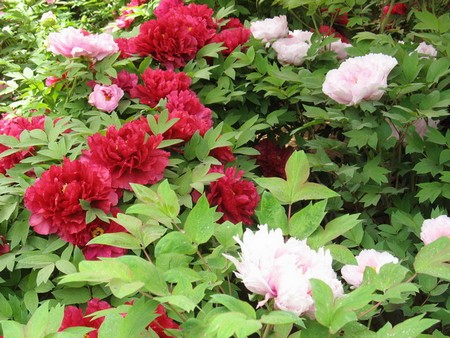This beautiful and exotic-looking flower comes from a family of 33 different species, native to Europe, China and North America. The peony is one of the most popular garden flowers — P. lactiflora, with its red, white or pink scented flowers was cultivated in China as long ago as 900BC. The peony is frequently depicted in Chinese art, often with peacocks and lions, decorating temple and palace walls as a motif.
The name peony derives from the mythical Paeon, physician to the Greek gods, and the god of healing. Leto, Apollo’s mother, gave him the peony on Mount Olympus where he used it to heal the wounds of Pluto, god of the underworld, and Ares, god of war, as recorded above in Homer’s Iliad.
The Greeks certainly regarded the peony as a sacred flower, with the power to keep evil spirits at bay. In other parts of Europe seeds were collected and threaded together on to white thread to wear around the neck to ward off evil. The roots were dried and carved into amulets in pagan times, and into beads for rosaries when Christianity arrived.
Although Culpeper said the peony is ruled by the sun, it was earlier thought to have been created by the moon goddess and to reflect her light through the night. It was said to ward off any unpleasant associations with darkness and was used for nightmares and melancholy dreams. In the Middle Ages many nervous diseases were considered manifestations of lunacy, and peony, as an emanation of the moon, was the sovereign remedy. The lunatic was often covered with peony plants as he lay down and arose with his senses fully restored. Both Dioscorides and Pliny mention the use of peony for nightmares and hysteria. In the language of flowers, peony was also a symbol of shyness or bashfulness.
Herbal remedy
Since the days of Dioscorides and Theophrastus, peony has been used for nightmares, hysteria, and pains of the womb. The dried root was given to women after childbirth to help expel the placenta and aid recovery. Culpeper recommended the fresh root for falling sickness (epilepsy) and the root or seeds for cleansing the womb after childbirth. He said the black seeds taken morning and evening would cure nightmares and melancholy dreams.
Peony acts to stimulate the uterine muscles and will aid contractions in childbirth and expulsion of the placenta. Through the centuries peony has been used for kidney stones, and a liver and gall-bladder remedy for gallstones. By relieving stasis of blood it can be used for varicose veins and haemorrhoids. As a tonic to the nervous system, it was used for spasm, epilepsy, nervous twitches and St Vitus’s dance.
In China peony root has been used as a medicine for thousands of years. Bai-sbao (cultivated root) is used for wounds, hypertensive headaches and poor circulation. It is helpful for diarrhoea, period pain, fevers and night sweats, and gastric ulcers. It has antibacterial, antiviral and anticonvulsive properties. It is calming and anti-inflammatory. Chi-shao (wild harvested root) is prescribed for pains in the chest, heat in the blood, absent or painful periods, dysentery and boils.
Homeopathic remedy: Paeonia
Paeonia is prepared from fresh peony root and used for symptoms of congestion of the blood. It is prescribed for ulcers, haemorrhoids, headaches, varicose veins, and griping pains in the abdomen associated with trembling and anxiety. Paeonia people are prone to nightmares and nervous oversensitivity, are easily frightened, depressed and excited.
The flower essence
Peony is now available as a flower essence and looks promising as a remedy for tense, fearful people who have nightmares and are easily affected by negative influences. It has an affinity for the moon, ‘lunacy’ and dispelling the forces of darkness, so appears an ideal remedy for emotional problems related to women’s monthly cycles such as PMS or menopausal depression. As a great healer, as the flower that healed Pluto the god of the underworld, peony is a good strengthener for unconscious fears, our ‘underworld’ that gives rise to disturbing dreams or apparently irrational fears. Peony is a remedy of light.

